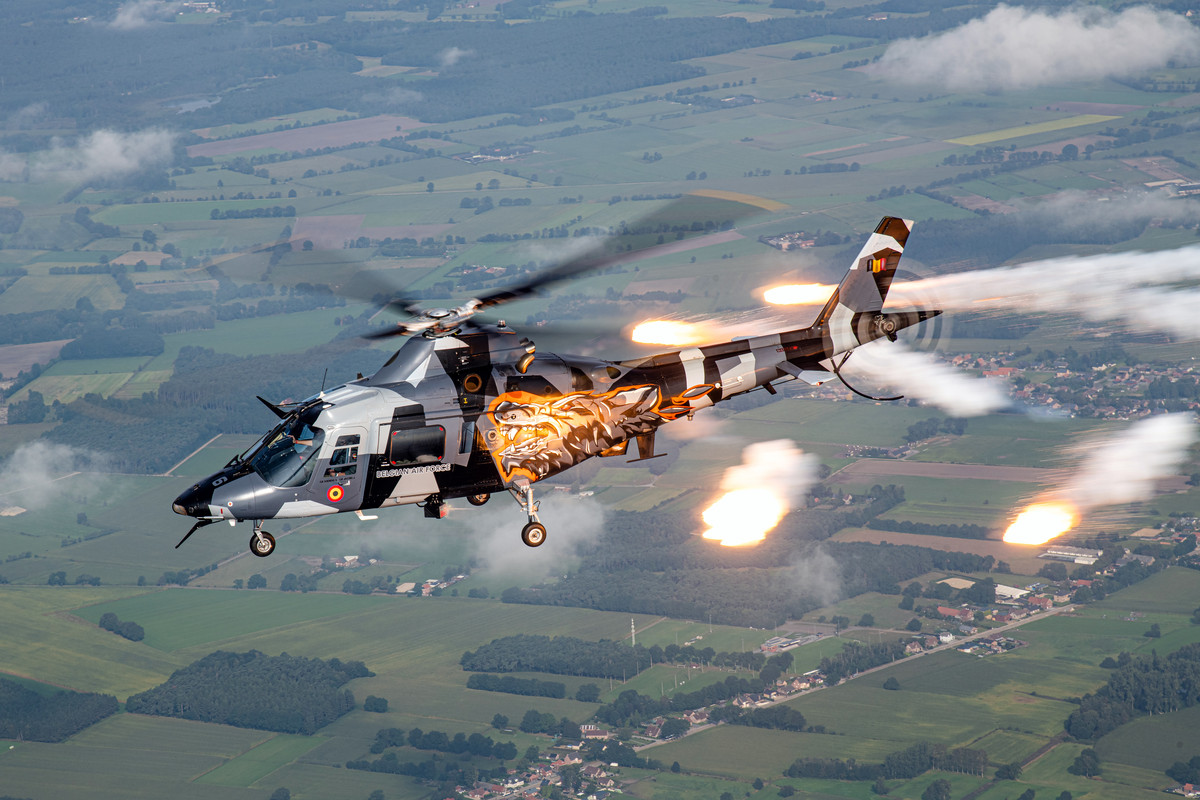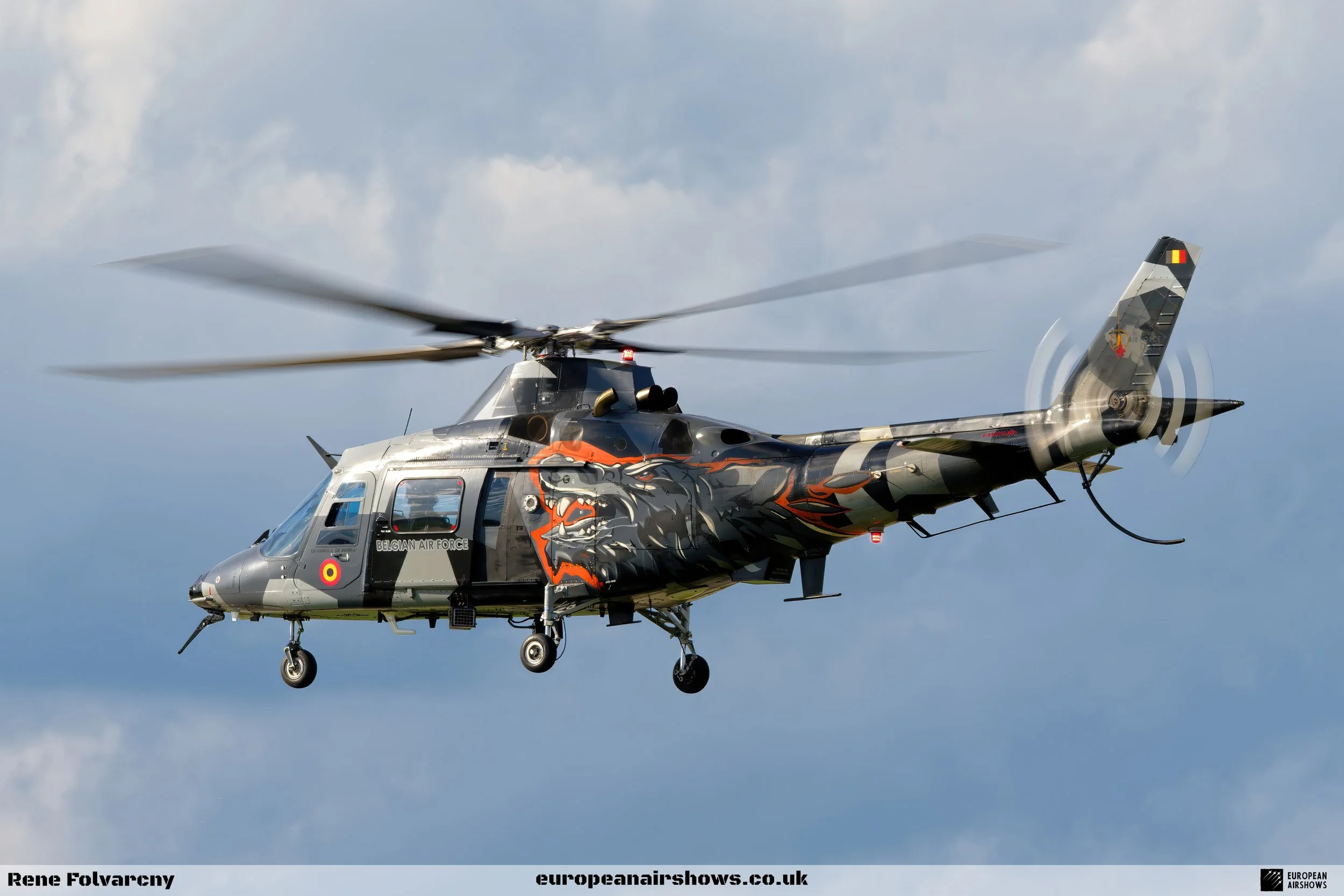
Belgian Air Force A109 Display Team
About the Aircraft
The AgustaWestland AW109, initially introduced as the Agusta A109, was developed by the Italian helicopter manufacturer Agusta starting in the late 1960s. Designed as a lightweight, twin-engine helicopter tailored for commercial operations, the A109 project emphasized market demands for reliability and versatility. The first prototype took to the skies on August 4, 1971, and after addressing dynamic instability issues through a modified transmission, the helicopter received certification from the Federal Aviation Administration (FAA) on June 1, 1975. By 1976, the A109 entered service, offering significant advantages over contemporaries like the Bell 206, including higher top speeds, enhanced safety through twin-engine redundancy, and increased seating capacity. Initially focused on the civil market, Agusta prioritized the A109C model, although military-oriented variants such as the A109B were also explored.
Following the merger of Agusta with the British company Westland Helicopters in July 2000, the A109 was rebranded as the AW109 under the newly formed AgustaWestland. This period marked significant international expansion, with final assembly lines established in Italy and the United States, and fuselages manufactured by Poland’s PZL-Świdnik from the mid-1990s. In 2004, AgustaWestland entered a joint venture with Changhe Aircraft Industries Corporation in China, further broadening the helicopter’s global footprint. Over four decades, the AW109 has seen continuous production, evolving through numerous iterations such as the AW119 derivative, which features a single engine and fixed undercarriage. Enhancements like the AW109 Trekker, introduced in 2014, incorporated advanced avionics and skid landing gear, underscoring the model’s adaptability and commitment to modern aviation standards.
Operationally, the AW109 has been utilized across a diverse range of roles, including VIP and corporate transport, emergency medical services, law enforcement, search and rescue, and various military applications. Its multirole capabilities have made it a preferred choice for both civilian and governmental operators worldwide. Notably, several countries’ military forces, including those of Italy, Belgium, and the United Kingdom, have employed specialized variants for tasks ranging from border patrol to high-altitude missions. The helicopter’s design allows for quick role adaptation through convertible interiors and optional mission-specific equipment, enhancing its functionality in dynamic operational environments. As of the late 2000s, the AW109 was recognized as one of the industry’s best-selling helicopters, a testament to its enduring performance, reliability, and versatility in meeting the evolving needs of the global aviation market.
Specifications
Crew
1 or 2
Capacity
6 or 7 passengers
Length
11.448 m (37 ft 7 in)
Height
3.50 m (11 ft 6 in)
Max Speed
311 km/h (193 mph, 168 kn)
Range
932 km (579 mi, 503 nmi)
Service Ceiling
6,096 m (20,000 ft)
Rate of climb
9.8 m/s (1,930 ft/min)
Agusta A109BA
The A109BA is a specialized military variant of the Agusta A109 helicopter, specifically developed for the Belgian Army. Building on the foundation of the civilian A109C model, the A109BA incorporated several modifications to meet the unique requirements of military operations. These enhancements included fixed landing gear for increased durability in diverse terrains, sliding doors to facilitate rapid ingress and egress, and a tail rotor guard replacing the lower tail fin to enhance safety during maneuvers and ground operations. These adaptations ensured that the A109BA could effectively perform roles such as reconnaissance, liaison, and light transport, providing the Belgian Armed Forces with a versatile and reliable rotary-wing platform suited for various mission profiles.
In 1988, Agusta successfully delivered 46 A109BA helicopters to the Belgian Armed Forces, marking a significant expansion of the A109’s military applications. This procurement was intended to bolster Belgium’s aerial capabilities, offering a modern and capable helicopter for both domestic and international missions. However, the sale of the A109BA became the center of a major political scandal when it was alleged that Agusta had provided a bribe of over 50 million Belgian francs to the Flemish Socialist Party to secure the contract. The ensuing scandal had profound repercussions, leading to the resignation and eventual conviction of NATO Secretary General Willy Claes. Despite the controversy, the A109BA continued to serve within the Belgian military, demonstrating its operational value and versatility in various capacities.
Operationally, the A109BA proved to be a valuable asset for the Belgian Armed Forces, participating in a range of missions from aerial displays to medical evacuations. The helicopters were utilized by the Belgian aerial display team, showcasing the A109BA’s agility and performance capabilities. Additionally, Belgian AW109BA helicopters were deployed in humanitarian efforts, such as the 2013 mission to Sévaré, Mali, in support of Operation Serval, where they performed critical medical evacuation tasks. The A109BA’s ability to adapt to different roles through its convertible interior and optional mission-specific equipment underscored its flexibility and effectiveness in fulfilling diverse operational needs. Despite the initial procurement challenges, the A109BA maintained its status as a reliable and multifaceted helicopter within the Belgian military infrastructure.
Did You Know?
- The AW109 holds the distinction of being the first all-Italian helicopter to be mass-produced, showcasing Italy’s prowess in rotorcraft engineering.
- Originally launched as the Agusta A109 in the late 1960s, the helicopter was rebranded to AW109 following the merger of Agusta and Westland Helicopters in 2000.
- The AW109 has been adapted for a myriad of missions, including VIP transport, search and rescue, medical evacuation, and various military operations, demonstrating its multifaceted capabilities.
- In 2014, the AW109 Trekker variant was unveiled, featuring skid landing gear and enhanced utility features that expanded its operational versatility compared to standard models.
- Since the mid-1990s, the Polish aerospace company PZL-Świdnik has manufactured fuselages for the AW109, contributing to its sustained production and international presence for over four decades.
Test Your Knowledge
Performer Information
The Belgian Air Force A109 Display Team, known by their callsign “Razzle Blades,” was a distinguished demonstration team within the Belgian Air and Space Component. Operating from Beauvechain Air Base, the team prominently showcased the agility and performance capabilities of the Agusta A109BA helicopter through dynamic aerial displays at various European airshows and events.
Their performances were particularly renowned during sunset displays, such as those at the Sanicole Sunset Airshow, where the use of flares added spectacular visual effects against the twilight sky. These exhibitions highlighted the versatility and maneuverability of the Agusta A109BA.
In 2021, the Agusta A109 helicopters received a complete repaint, adopting a more contemporary and modern aesthetic. The new livery featured a disruptive camouflage pattern in three shades of grey, designed to complement the squadron’s wolf insignia. This camouflage, inspired by the World War I-era “razzle dazzle” technique, was intended to obscure the aircraft’s silhouette and complicate the estimation of its distance and flight path, enhancing its visual intrigue during performances.
The “Razzle Blades” were led by Commander Jo Jacobs and Commander Stijn Soenens, both highly experienced pilots with 1,600 and 1,700 flight hours on the Agusta A109, respectively. Having been integral members of the team for several years, Commander Jacobs and Commander Soenens brought a wealth of experience and expertise, culminating in their performance of the team’s very last demonstration flight. Their longstanding dedication ensured the team’s high level of professionalism and safety during performances. Supporting the two pilots was a dedicated team of six engineers who maintained the helicopters and ensured their optimal performance during displays, playing a crucial role in the execution of complex aerial routines.
Shortly before the Belgian Air Force Days 2023, the team announced that their performance on Sunday, September 10, 2023, would mark their final public display. To honor this occasion, the A109 helicopters were adorned with temporary Belgian Air Force Day markings on their tail fins in addition to the existing “Razzle Blades” paint scheme. Commander Jo Jacobs and Commander Stijn Soenens performed the very last demonstration, symbolizing the culmination of their years of service with the team. While the display had been a fixture at European airshows for many years, in 2023 the team participated in two major airshows and several smaller events, culminating their illustrious display career with memorable final performances.
The Belgian Air Force A109 Display Team played a significant role in representing the capabilities of the Belgian Air Component to both national and international audiences. Their performances not only demonstrated the technical prowess of the Agusta A109BA but also served as a symbol of national pride and military excellence. The legacy of the “Razzle Blades,” particularly through the dedicated efforts of pilots like Commander Jo Jacobs and Commander Stijn Soenens, continues to inspire future generations of aviators and upholds the tradition of aerial excellence within the Belgian Air Force.
Inactive Status
The team was disbanded at the end of the 2023 European Airshow season.












